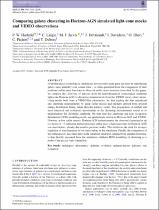Comparing galaxy clustering in horizon-agn simulated light-cone mocks and video observations
Abstract
Hydrodynamical cosmological simulations have recently made great advances in reproducing
galaxy mass assembly over cosmic time – as often quantified from the comparison of their
predicted stellar mass functions to observed stellar mass functions from data. In this paper,
we compare the clustering of galaxies from the hydrodynamical cosmological simulated
light-cone Horizon-AGN to clustering measurements from the VIDEO survey observations.
Using mocks built from a VIDEO-like photometry, we first explore the bias introduced
into clustering measurements by using stellar masses and redshifts derived from spectral
energy distribution fitting, rather than the intrinsic values. The propagation of redshift and
mass statistical and systematic uncertainties in the clustering measurements causes us to
underestimate the clustering amplitude. We then find that clustering and halo occupation
distribution (HOD) modelling results are qualitatively similar in Horizon-AGN and VIDEO.
However, at low stellar masses, Horizon-AGN underestimates the observed clustering by up
to a factor of ∼3, reflecting the known excess stellar mass to halo mass ratio for Horizon-AGN
low-mass haloes, already discussed in previous works. This reinforces the need for stronger
regulation of star formation in low-mass haloes in the simulation. Finally, the comparison of
the stellar mass to halo mass ratio in the simulated catalogue, inferred from angular clustering,
to that directly measured from the simulation validates HOD modelling of clustering as a
probe of the galaxy–halo connection.

